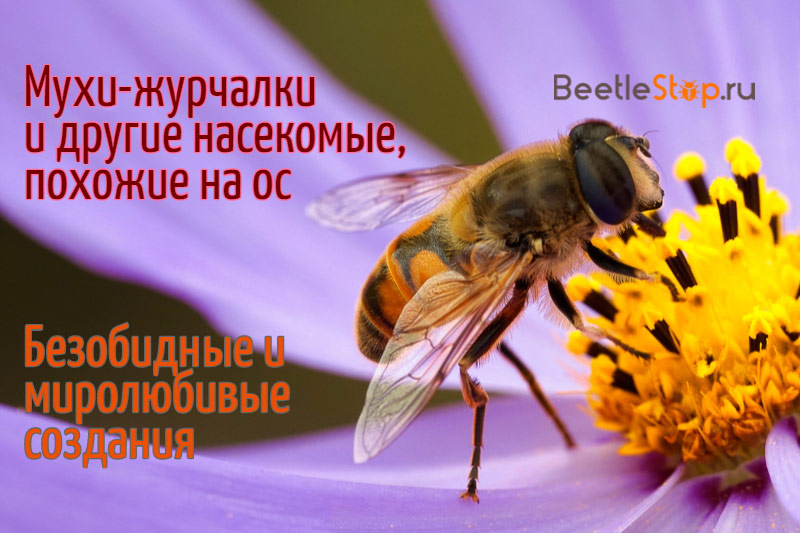What insect looks like a wasp, what is it dangerous
Wasps are famous for their bright color, aggressive behavior, love of sweet foods and painful bites. However, in nature there is an insect similar to a wasp, whose characteristics are directly opposite. The only thing that connects him with a stinging creature is its appearance. For the rest, it is a completely harmless and peaceful creation.

Why insects imitate wasps
Wasps, in order to feed and raise their offspring, are forced to hunt. They are able to attack even insects, which are inferior in size. Powerful jaws and poison, which they inject into their prey, help them cope with the victim. Due to the predatory features of wasps, many representatives of the fauna are afraid of them and prefer to stay away from dangerous predators. Weaker individuals imitators took advantage of this.
There is also a hypothesis, confirmed by studies that some insects mimicking under wasps, camouflage color protects them directly from the models themselves. A striking example of this: predatory South American wasps and exactly the peaceful butterfly moths imitating them, scoops, which not every specialist manages to distinguish. In the course of observations, it was noticed that wasps did not attack their own kind.
There are many insects similar to wasps in the world. Consider the most interesting and colorful representatives.
Ghost flies
Creepers, they are also sirfids - a large family in which there are about 6,000 species. Some of them are more like bees, others like wasps, and others like bumblebees. They live everywhere, with the exception of Antarctica, desert regions and the tundra. They got their name because of the characteristic sound made by the wings.
Interesting! The study of beetles is done by syphidologists. They even hold special symposia on flies research.
A striped insect, similar to a wasp, is absolutely harmless to humans. Often it can be found on plantings of dill, carrots, parsley, flowering plants in the garden. Adult beetles feed exclusively on flower nectar, pollen and take pride of place among pollinating insects
What do larvae of gourds
Sarfid larvae look like little leeches. They are distinguished by a shriveled body of yellow or greenish color. They have no legs and they are not characterized by special mobility. They feed on aphids, insect eggs, spider mites, which bring considerable benefits to agricultural land. Caring mother-sirfida lays eggs directly in the aphid habitat.
The development period of the larvae of the larva lasts 15-20 days. Young individuals are very voracious and by the end of growing up eat up to 200 aphids, and in general during their life destroy about 2000 small insects.
However, not all larvae of beetles prefer to see garden pests on the menu. Food addictions for all species are very diverse. Some of them are purely vegetarians and only taste plant tissue. The most exotic representatives process manure or wood.
Butterflies in the image of wasps
A large insect that looks like a wasp can be quite common butterfly glass box. However, not only this is noteworthy in the air fluttering creatures.Most of them are distinguished by transparent wings. And if not for the contrasting bordering, it would be impossible to visually determine the presence of wings.
The most common species in the European part are poplar, currant, and apple. An exceptionally bright yellow striped body color and manner of flight connect the insect with a wasp. The rest is a typical garden pest. The female lays eggs under the scales of the bark near the kidneys. After a few days, caterpillars appear from them, which gnaw holes in the shoots and penetrate deep into the plant. They gnaw out the core, gradually descending to the base of a tree or bush. After wintering, they continue to eat the plant from the inside.
And although an insect, similar to a wasp, does not bite a person, the harmfulness from it is significant. The offspring is located inside the trunks, branches, therefore, it is only necessary to deal with the emerging pest in a radical way - cutting and destruction of the affected areas.
An interesting picture is the mating games of glass-box butterflies. Males gather in a circle near the female and begin to flutter around the lady, as if surprising her with her abilities and showing herself in all its glory. The female can only choose the individual she likes.
Insect copycats
A black insect similar to a wasp is a predator. Outwardly, it has much in common with predatory road wasps that can hunt even poisonous spiders.
Unlike its predecessors, a predator does not need to mimic under wasps. He himself belongs to predators, eats insects, larvae. Some tropical species prefer human or mammalian blood. Daytime is spent in shelter, hunting goes out at night. They are remarkable for their endurance and are able to wait for their victim for several hours.
At the sight of prey, the predator bug makes a sharp attack, plunges its proboscis and injects poisonous enzymes. Further, it is already a technical matter and it is not difficult to cope with an immobilized object by an insect. The hunting process is similar for a road wasp.
It is impossible not to mention another black insect, similar to a wasp. This is a representative of barbel beetles plagionotus. Its dark body is generously showered with yellow spots, stripes, which allows the beetle to impressively lodge in flowers, without fear of competition from wasps or bees.
The striped beetle eats nectar and takes part in the pollination of flowers. In case of danger, it begins to quickly flap its wings, thereby strengthening the resemblance to a wasp.


 (votes: 6, average rating: 4,33 out of 5)
(votes: 6, average rating: 4,33 out of 5)